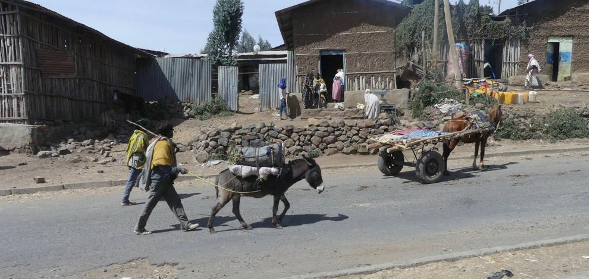People’s ways of eating, what they grow, how they cook it, share it and their food customs, develop over time as part of their culture and in response to their environment. Charmian Smith discovers how food and culture are interrelated in Ethiopia.

You don’t go to Ethiopia for the food, someone pointed out when I mentioned we were heading to that ancient country in the Horn of Africa.
Ethiopia may not be a culinary destination such as Italy or Thailand, but its unique culture and history, not to mention its environment, have produced an equally singular cuisine.
It may come as a surprise but Ethiopian cuisine is making inroads in places like New York, partly for its rich spicy flavours, but also because it offers a variety of delicious vegan dishes that meet a growing trend for plant-based foods, as well as lots of meaty stews.

Many Ethiopians, especially in the mountainous north, are devout Christians and fast twice a week on Wednesdays and Fridays, and during Lent, which they observe for 55 days before Easter. This means avoiding all animal products, so a delicious variety of plant-based dishes has evolved. They don’t rely on meat substitutes, but make versatile use of legumes such as lentils, chickpeas, beans and the iron-rich, indigenous grain, teff.
Teff, these days often included in the ‘‘ancient grains’’ category of highly nutritious, naturally gluten-free grains, is the Ethiopian staple. It’s used to make injera, a fermented, soft, spongy, pancake-like sourdough bread, smooth on the bottom and textured with little air bubbles on the top.
Injera is served with every meal, sometimes in neat rolls alongside the delicious stews, but often on a large shared plate or tray with portions of various stews and vegetables. Its slightly sour flavour goes well with the spicy vegetable and meat stews.
We learned how to make injera from Sisaynesh Gebeyaw and her family who conduct cooking demonstrations in Lalibela, a town famous for its ancient churches hewn into the living rock and now a Unesco World Heritage site.
On a terrace below their house overlooking one of the deep gorges that cleave the town, we gathered at tables decorated with scattered red and green leaves.
To make injera, teff flour is mixed with water and left for a day or two to start fermenting. When it bubbles and smells yeasty you stir in warm water to make a thin dough with a pancake consistency.
To cook, it is poured thinly but evenly into a circle on to a hotplate greased with ghee or canola and covered with a lid, over medium heat for about five minutes. It bubbles to form a lacy surface on the top, a bit like a thin English muffin. Lift the edges with a spatula to check it is done underneath and when it is, move the injera to a large flat basket or plate. Then cook another — and another.
When cold, injera can be rolled, cut into neat sections about 10cm-15cm wide and served alongside a variety of thick stews or wat. But Ethiopian food is about sharing so it’s usually laid flat on a large plate or tray — to the uninitiated it can look rather like a linen tablecloth. Topped with portions of colourful red and green stews, vegetable dishes and salads to make a sharing plate, it looks like an artist’s palette. By itself injera has a light sourness and soft texture, but this only enhances the spiciness of the accompanying stews. Ethiopians eat with the fingers of their right hand, tearing off pieces of injera and using them to scoop up mouthfuls of the stews.
Ethiopians make good use of spices, both hot and mild, in their many wats and other dishes.
Perhaps the most common combination is berbere, a hot, fragrant spice mix that includes chilli, garlic, ginger, basil, ajowan, nigella, fenugreek and korarima (Ethiopian or false cardamom, a relative of ginger) and often other spices such as black pepper or allspice. It can be found in specialist shops or you can make your own — there are numerous recipes on the internet, each slightly different as indeed they are in Ethiopia.
Mitmita is another common seasoning, a mix of birdseye chillies, Ethiopian cardamom, cloves and salt, and sometimes cinnamon, cumin, ginger and other spices.
Sisay also shows us how to make shiro, a flavoursome spicy dish with chickpea or broad bean flour that’s a real comfort food. It can be thin like a soup or thicker like a stew. She makes her own mix which includes garlic, ginger, dried basil, black cumin, black pepper, all roasted and ground with chickpeas and/or dried broad beans.
To cook it, she starts with the Ethiopian technique of slowly softening finely chopped onion in a dry clay pot until creamy — this is said to give a characteristic flavour and helps thicken the stew. Only then does she add oil and chopped tomato to cook down before adding half a litre of boiling water and about three heaped tablespoons of her shiro mix. After stirring it together and cooking for 5-10 minutes until thickened, she stirs in about 5 cloves of chopped garlic. Ethiopians love garlic, she says.
There are many versions of wat. For non-fasting days, doro wat is an ubiquitous chicken stew. ‘‘Tibs’’, meaning little pieces of meat or mince, can be found regularly — beef or lamb or chicken tibs are spicy meat stews. There is even kifto, a dish of spiced raw beef, a bit like a steak tartare, although we were warned against eating it.
Even though the majority are Christian, Ethiopians do not eat pork, a legacy of their earlier Jewish heritage and the Muslim influence of the past 1200-odd years.
However, freshwater fish from Ethiopia’s many rivers and lakes, especially Nile perch and tilapia, can be found on menus, usually fried.
Ethiopians enjoy alcoholic drinks, many of which are made at home, as Sisay does. She ferments her own beer, areki, a grain spirit and tej, Ethiopia’s famous honey wine.
Tej is made from barley or maize malt, honey and gesho (the hop-like bark of buckthorn trees). It’s yellow and fragrant with aromas of honey, refreshing with a hoppy bitterness similar to beer and has a dry finish — at least one we tried at the renowned Four Sisters restaurant in Gonder was. However, I’ve read of others that were described as tasting like diesel or old socks — obviously they vary in quality and alcohol content. Traditionally tej is served in a flask-like pitcher or bottle, called a bereles.
Along with wheat bread, local grape wine is used in Christian communion services, according to our Ethiopian guide, Afe. We found grape wine in hotels and restaurants — sweeter reds seemed popular but we tended to stick to some very acceptable dry reds, particularly syrah, from Rift Valley Winery, part of an international winemaking conglomerate.

However, the national drink is coffee. Coffee is native to Ethiopia and, according to legend, the process of roasting and brewing the berries was discovered there somewhere between the 7th and 9th centuries CE. Whether that is true or whether the process was discovered in neighbouring southern Arabia across the Red Sea and a major trading partner in the past, the Ethiopians have evolved an elaborate coffee ceremony. It was formally instituted as a ritual by emperor Menelik in the 19th century.
Afe says families and friends do it every day and it’s a sign of respect and friendship, a time to talk and discuss matters.
Besides coffee, essential accoutrements are fresh grass and incense which is grown in the north of the country.
Every restaurant or hotel that serves Ethiopian food will offer coffee made the traditional way. One hotel we saw in an out-of-the-way place had the equipment for making local coffee set out in front of the espresso machine!
The coffee ceremony starts with spreading the fresh grass on the floor around charcoal braziers. A jebena, a black clay coffee pot with a long neck and spout, is filled with water and put on to heat. Frankincense, an essential part of the ceremony, is sprinkled on a brazier, filling the air with a characteristic aroma of incense.
The raw coffee beans are warmed and washed in a shallow pan over hot coals, drained, then roasted in a dry pan until dark. As the pan is shaken, the aroma, mingled with the incense is almost intoxicating. The roasted beans are shown to the guests so they can enjoy the fragrance.
The beans are pounded to a powder in a mortar and pestle and spooned carefully into the long neck of the jebena. This is brought to the boil, then removed from the heat. Coffee grounds float and the long spout of the jebena is set low so the liquid is poured from below the floating grounds.
When it has settled, the coffee is poured from a height into the small, handleless cups sitting neatly side by side on a tray. Sometimes a sprig of rue is put on the saucer which can add an intriguing but pleasing flavour to the coffee. The cups are passed round and sugar is offered. Ethiopians don’t drink milk with their coffee.
To nibble with coffee there may be freshly popped corn, roasted nuts or pieces of himbasha, a large wheaten flatbread sweetened with honey.
Perhaps not surprisingly given the Italian influence — a failed attempt at colonisation in the 19th century then occupation from 1935-41 — there is also a legacy of Italian food, particularly pasta and pizza. Spaghetti with a tomato-based sauce was often served as a vegetarian alternative on tourist hotel ‘‘Western’’ menus.
In fact, at first it was difficult to find Ethiopian food on our tour. We were offered fairly bland Western food in hotels — dry, often tough grilled chicken, potatoes, greens and carrots.
Breakfast was omelettes of various flavours, and porridge, sometimes fresh fruit and toast, and usually freshly pureed fruit juice such as papaya, guava, and, one memorable day, avocado.
However, we soon learned that most hotels and cafes serve Ethiopian food if you ask and started to explore some of the delicious wats, vegetables, and the soft spongy injera.









Recent Comments